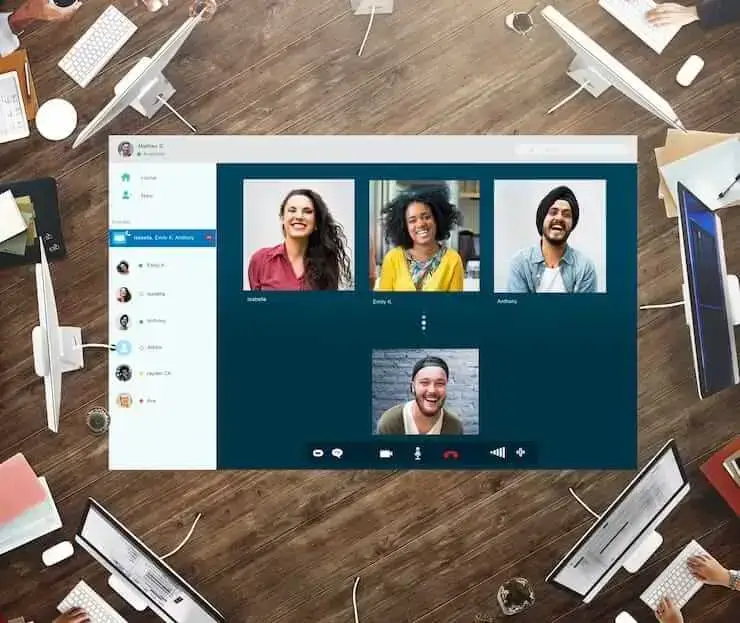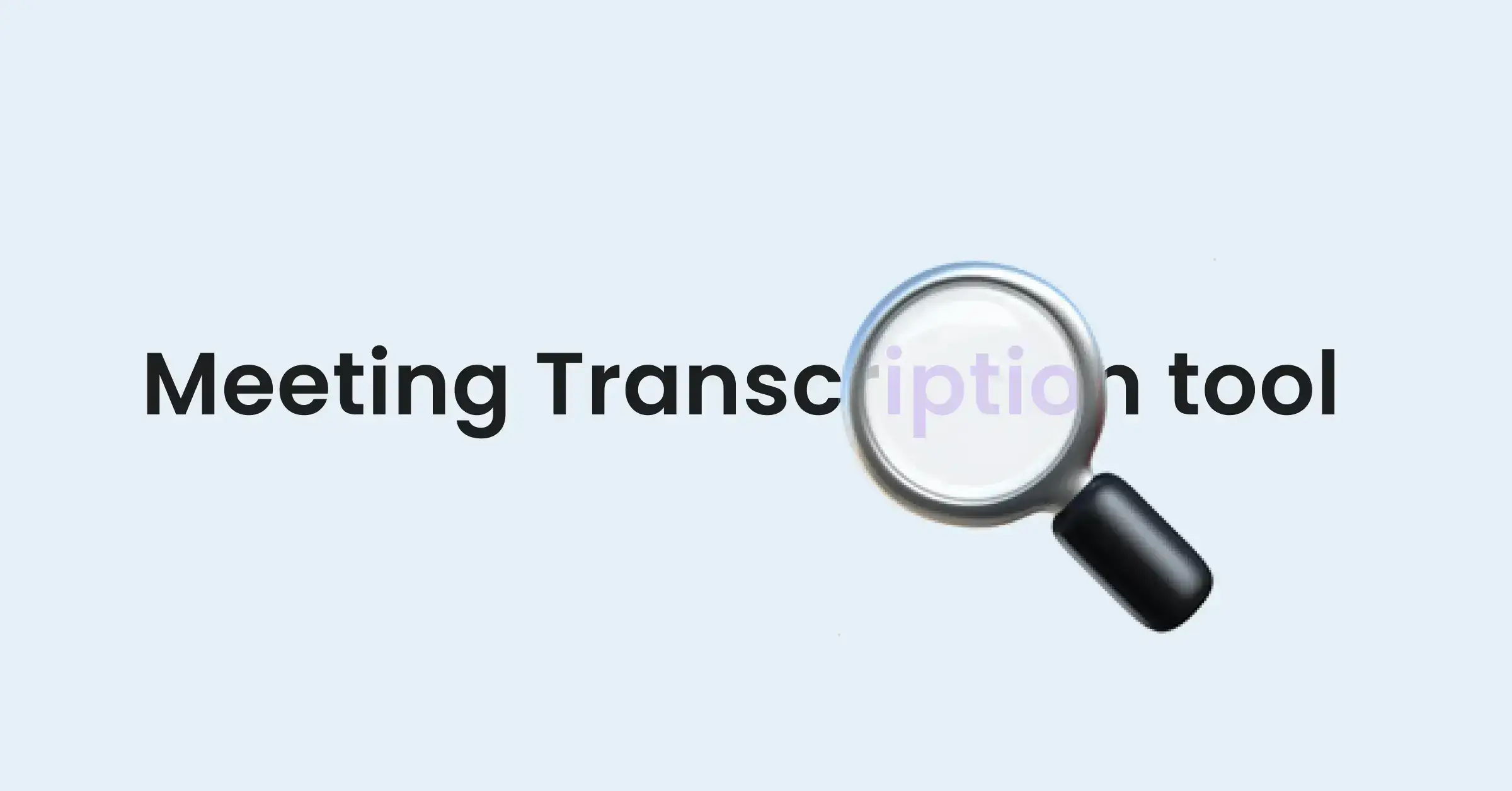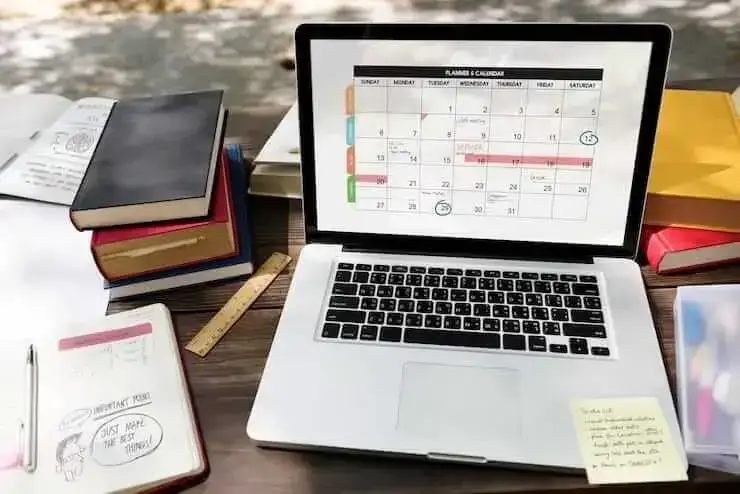How to Set Up a Teams Meeting: A Step-by-Step Guide for Beginners
Learn to set up a Teams meeting effortlessly with our beginner-friendly guide. From scheduling to inviting, we cover every step!
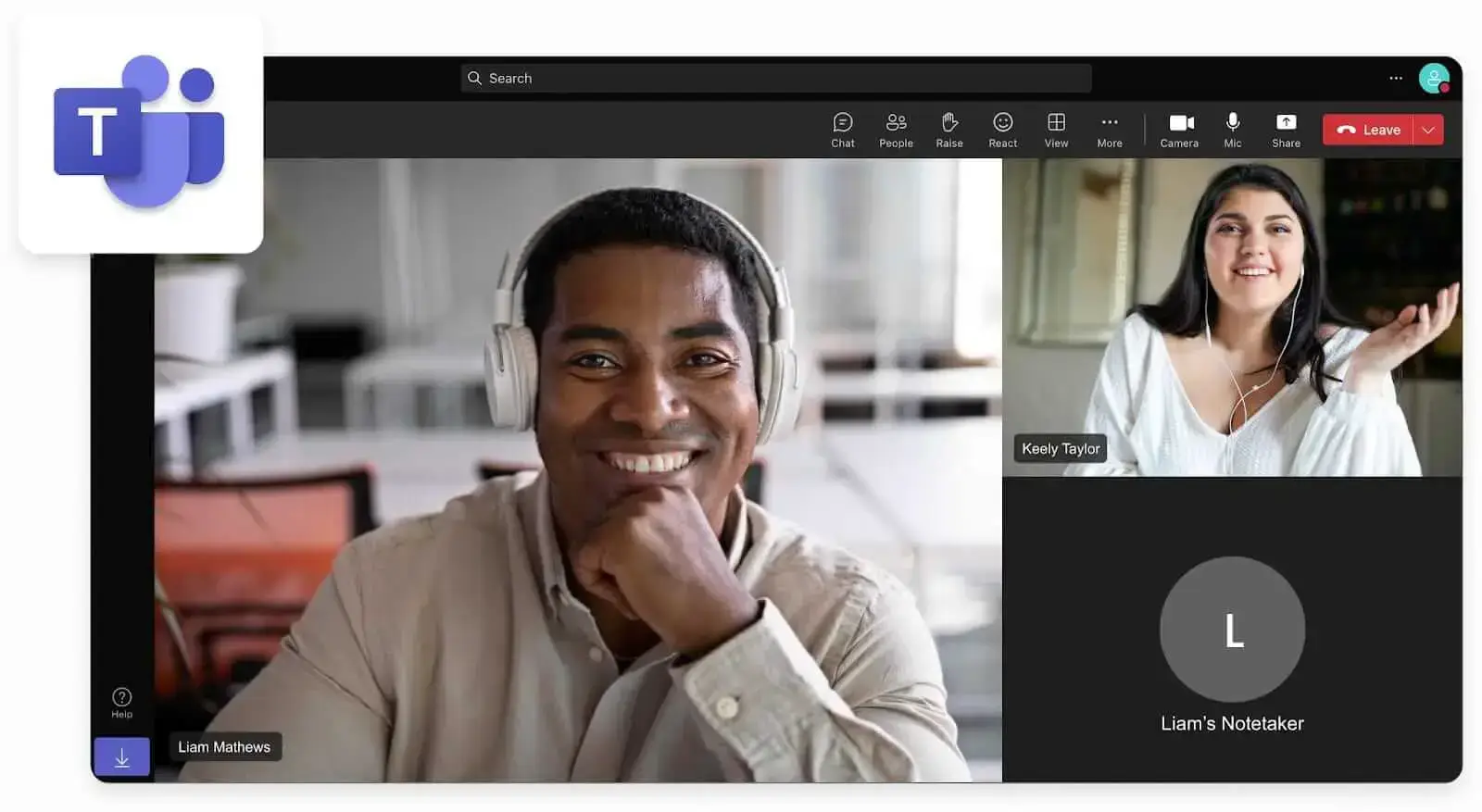
✅ Free meeting recording & transcription
💬 Automated sharing of insights to other tools.

In today's world, the ability to connect and collaborate easily and effectively is crucial, especially in the business realm. With over 300 million users, Microsoft Teams is a top choice for online communication, bringing people together no matter where they are.
If you’re struggling to set up a Teams meeting or are simply new to the platform, don't worry. Our beginner-friendly guide is here to help you effortlessly organize and lead your virtual gatherings on this platform.
We'll take you through every step, from scheduling to keeping your participants engaged, ensuring your virtual meetings are both productive and enjoyable. Shall we begin?
Microsoft Teams’ Best Features for Meetings
Microsoft Teams powerfully combines communication and collaboration, offering features that meet the needs of today's dynamic work environment.
Here are Microsoft Teams’ best features for meetings:
- Audio and video calls: Teams offers crystal-clear audio and video calls, making communication smooth whether you're talking to team members or external partners.
- Online meetings: You can schedule meetings right from your Outlook calendar, invite attendees with a simple email, and even start spontaneous meetings with the ‘Meet Now’ feature.
- Meeting chat and instant messaging: The chat and instant messaging in Teams keep the conversation going before, during, and after your meetings. This allows participants to share thoughts, ask questions, and give feedback without interrupting.
- File sharing: You can directly upload files to the chat or share your screen to present documents to make meetings more engaging and fruitful.
- Collaborative workspace: Teams enables you to create, share, and work on documents with other team members in real-time. Through integrations with Office apps like Word, Excel, and PowerPoint, teamwork can happen smoothly without leaving the app.
- Channels: Seamlessly organize conversations by topics, projects, or departments through dedicated channels to make finding relevant information easier.
- Integration with other apps: Bring your favorite project management tools, CRM software, or design apps into Teams to keep all your essential tools in one spot.
- Security and legal compliance: Multifactor authentication and end-to-end encryption, along with compliance with global standards, ensure your meeting data is secure.
How to Set Up Your First Microsoft Teams Meetings
To ensure that every Teams gathering turns into a successful meeting, you must cover all your bases. Read on to discover how to set up a Microsoft Teams meeting!
A. How to Set Up a Teams Meeting on Desktop
Here’s how to set up a Teams meeting on a desktop:
- You can easily download the Microsoft Teams app from Microsoft’s website. Launch it and sign in with your organizational account. If you’re using a Mac, here’s how to install Microsoft Teams step by step.
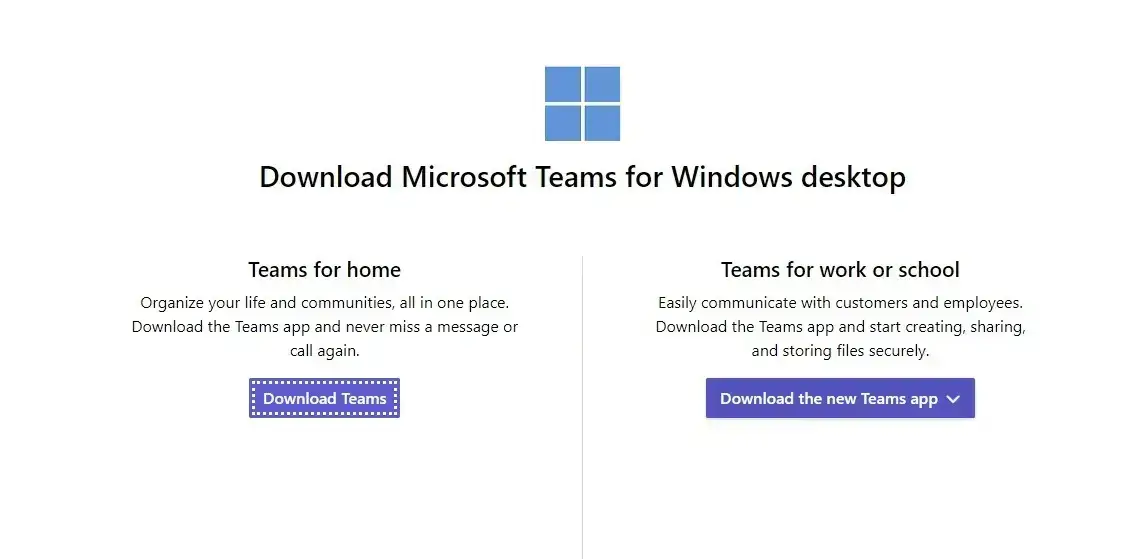
- On the left-hand side menu, find the ‘Calendar’ icon and select it. This will bring up your Teams calendar, showing your schedule and any meetings you've already set up or been invited to.
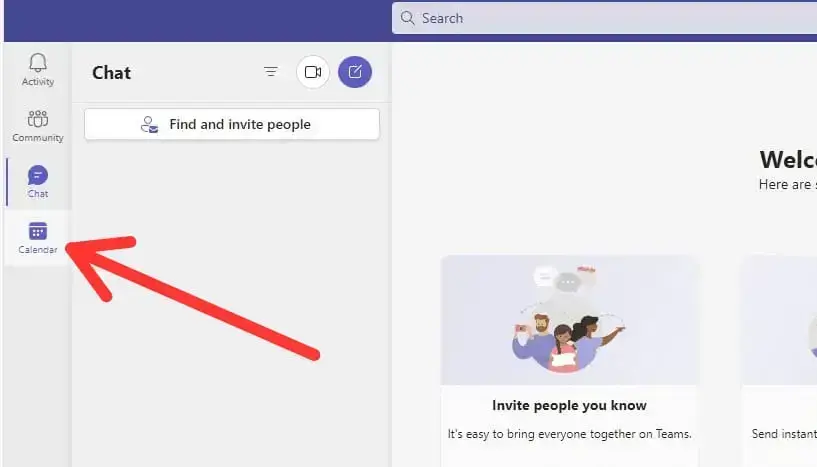
- In the calendar view, click on the ‘New Meeting’ button, found in the top right corner of the app. This will open the meeting scheduling form.
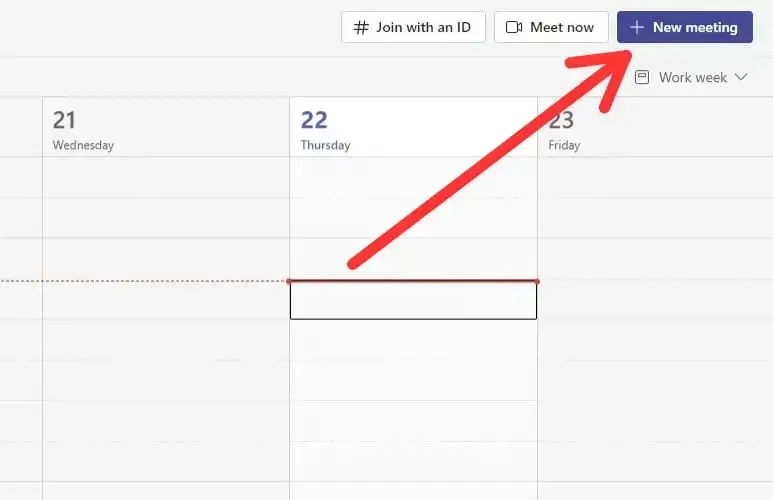
- On the ‘New Meeting’ form, you'll need to provide additional details about your meeting:
- Title: Pick a concise, descriptive title for your meeting.
- Date and time: Select the start and end times for your meeting.
- Attendees: Invite people by adding their names or email addresses to the ‘Add required attendees’ field for mandatory participants, or ‘Add optional attendees’ for those whom you wish to invite but are not mandatory. As you type, Teams will suggest contacts from your organization.
- Channel (optional): If you want to associate the meeting with a specific team channel, you can select one from the ‘Select a channel to meet in’ dropdown. This makes the meeting accessible to all members of that channel.
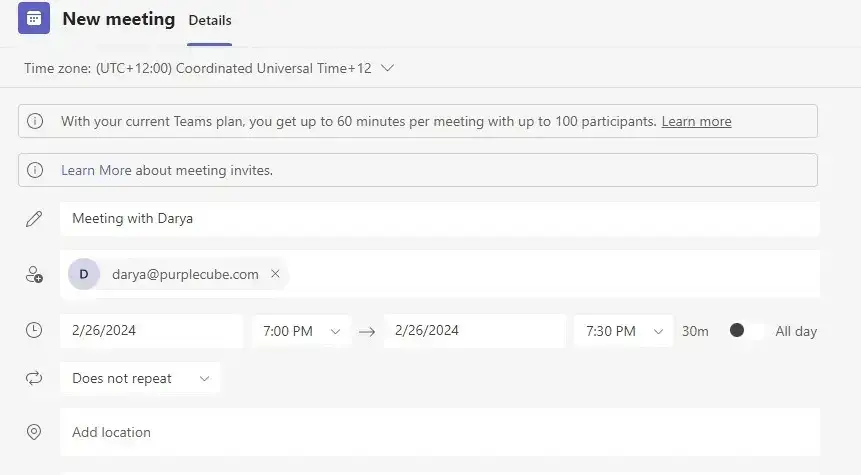
- If this will be a recurring meeting, click on the ‘Does not repeat’ option to set your meeting to recur daily, weekly, monthly, or at a custom interval.
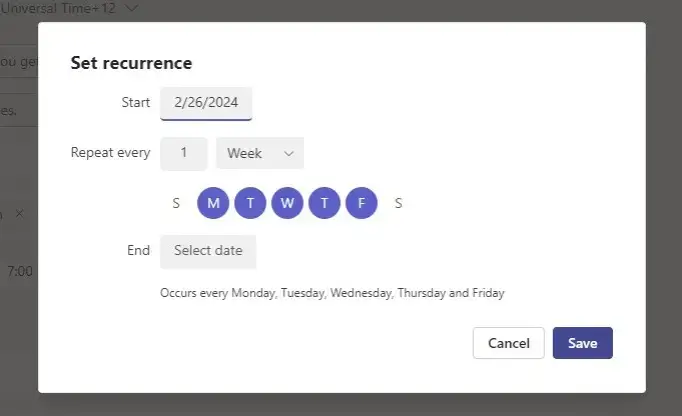
- Use the ‘Add description’ box to input the meeting details or specific instructions for the meeting.

- Once all details are accurately filled in, click the ‘Send’ button, found at the top right of the form. This will save the meeting to your calendar and send a meeting invitation to every participant you've added.

- Once the meeting is saved in your calendar, you can go to ‘Adjust Meeting Options’ for more actions, such as who can bypass the waiting room or whether attendees can present.
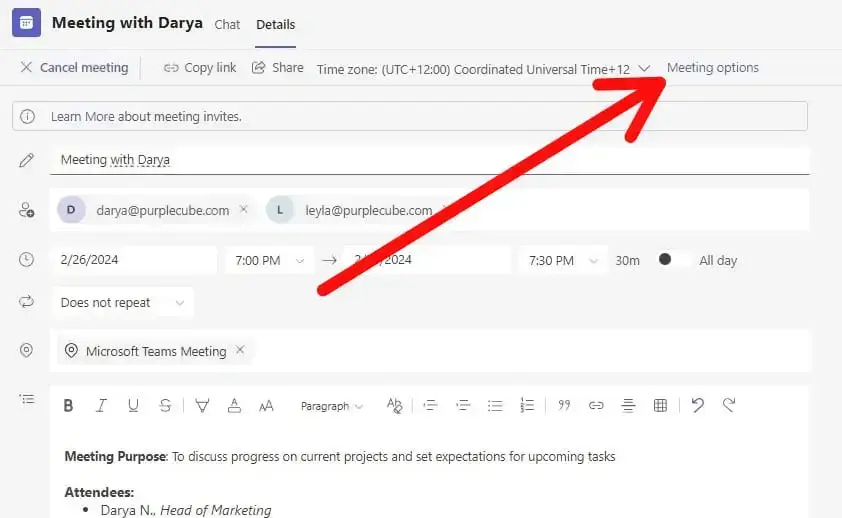

B. How to Set Up a Teams Meeting on Mobile
Here’s how to set up a Teams meeting on a mobile device:
- Open the Microsoft Teams app on your mobile device. If you haven't already, download it from the Google Play Store (for Android devices) or App Store (for iOS devices) and log in with your credentials.
- Once in the app, tap on the ‘Calendar’ icon located at the bottom of the screen to access your Teams calendar.

- In the top right corner of your screen, find and select the ‘New Meeting’ button (+) to start creating and customizing a new meeting.

- You'll be prompted to the ‘New Meeting’ screen, where you can enter all the necessary details for your meeting:
- Title: Give your meeting a clear and descriptive title.
- Start and end time: Pick the date and time for your meeting, adjusting the duration as needed.
- Attendees: Select participants by adding their names or email addresses to the ‘attendees’ field. Teams will suggest contacts as you type. You can add people as required or as optional attendees.
- Channel (optional): If the meeting is tied to a specific team or project, you can also select a class team channel to associate with the meeting. This makes the meeting visible to all channel members.
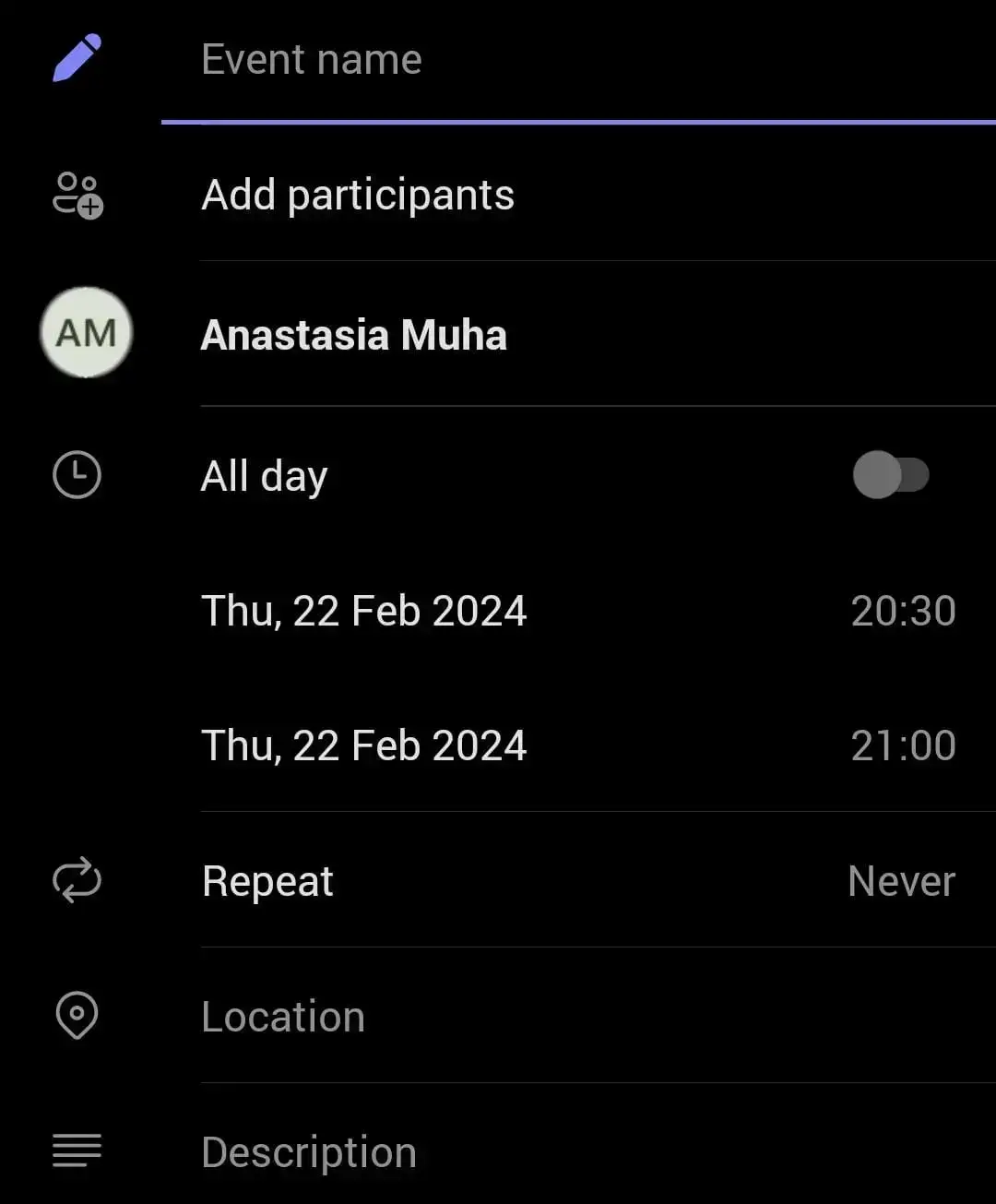
- If this meeting will happen regularly, tap on the recurrence option to set it as a daily, weekly, or custom recurring meeting.
- Use the ‘Add Details’ section to include the meeting agenda, objectives, or any pre-read materials.
- Once you've filled in all the necessary information, look for the ‘Done’ or ‘Save’ button in the top right corner of the screen. Tap it to save your meeting. Invitations will automatically be sent to all the attendees you've added.
- After finishing, you might want to adjust additional settings, such as whether you want the meeting to be a video call and if you'll allow attendees to join before the host does.
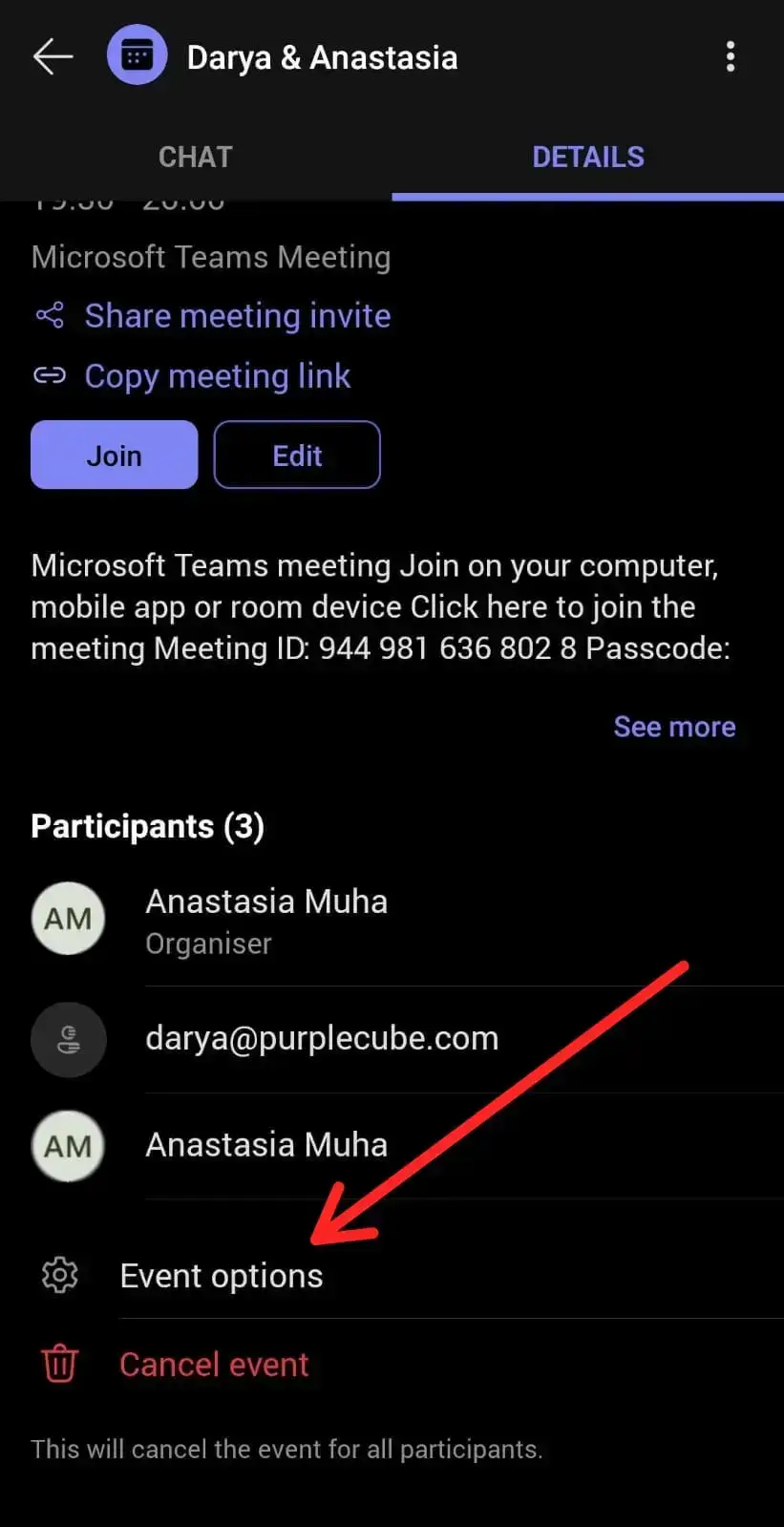
How to Schedule a Meeting in Microsoft Teams
If you’re looking for the quickest way to schedule a meeting in Microsoft Teams, you’re in the right place. Keep reading to learn how!
A. How to Schedule a Teams Meeting on Desktop
Here’s how to schedule a Teams meeting on desktop:
- Launch Microsoft Teams on your desktop.
- Select 'Schedule a meeting,' found beneath the 'Type a new message' field. This action will redirect you to the Calendar tab.
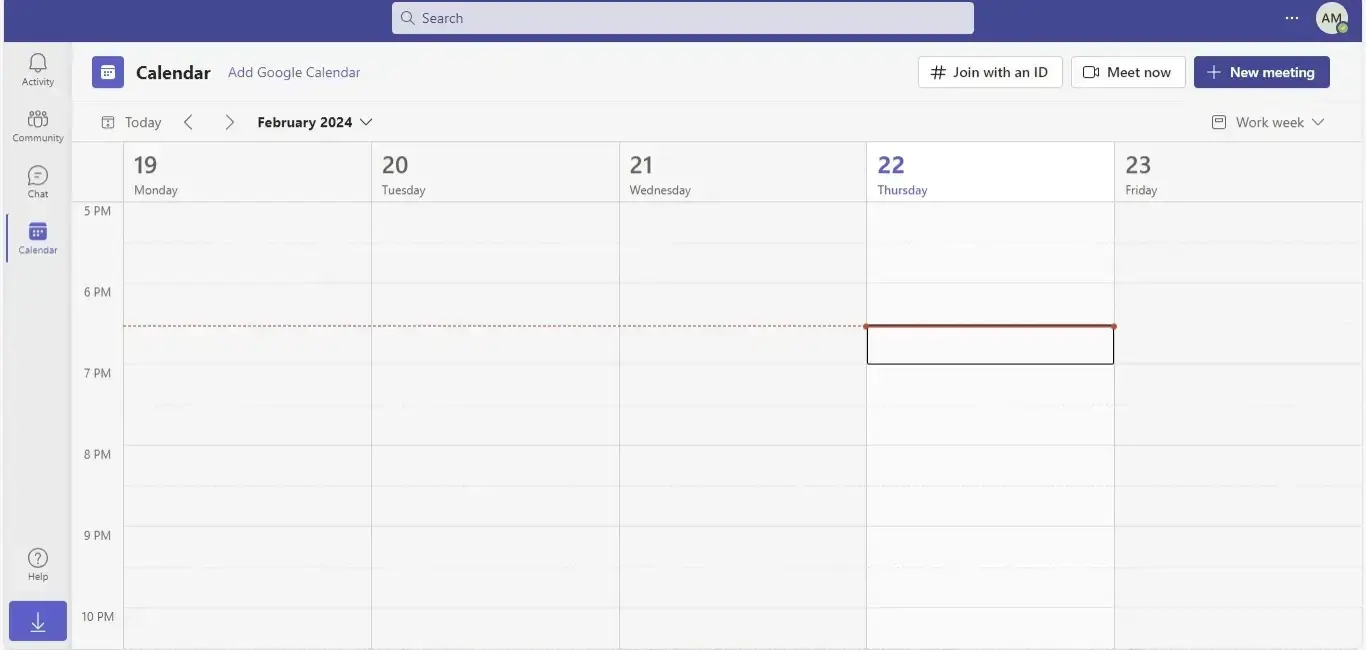
- In the upper right corner, click on the 'New Meeting' option to select the desired date and time for your meeting.
- In the form that appears, input the meeting's title, send out the invitations, and add other important details.
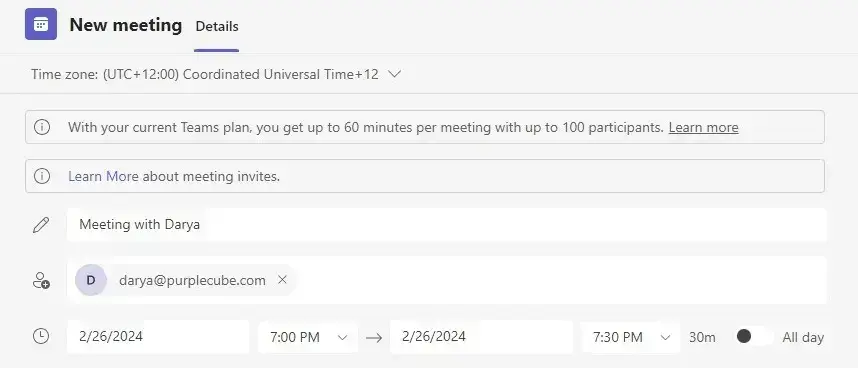
- To finalize, click 'Save.'
NOTE: Let Teams’ Scheduling Assistant help you identify a meeting time that accommodates both you and your team members effectively.
B. How to Schedule a Teams Meeting on Mobile
Scheduling a meeting in Teams is not limited to desktop use; you can also do so using the mobile app, available for both Android and Apple devices.
Here's how to schedule a Teams meeting on mobile:
- Tap on 'Calendar Meetings' at the bottom of the app.
- Click on the 'Schedule a Meeting' option in the bottom right corner.
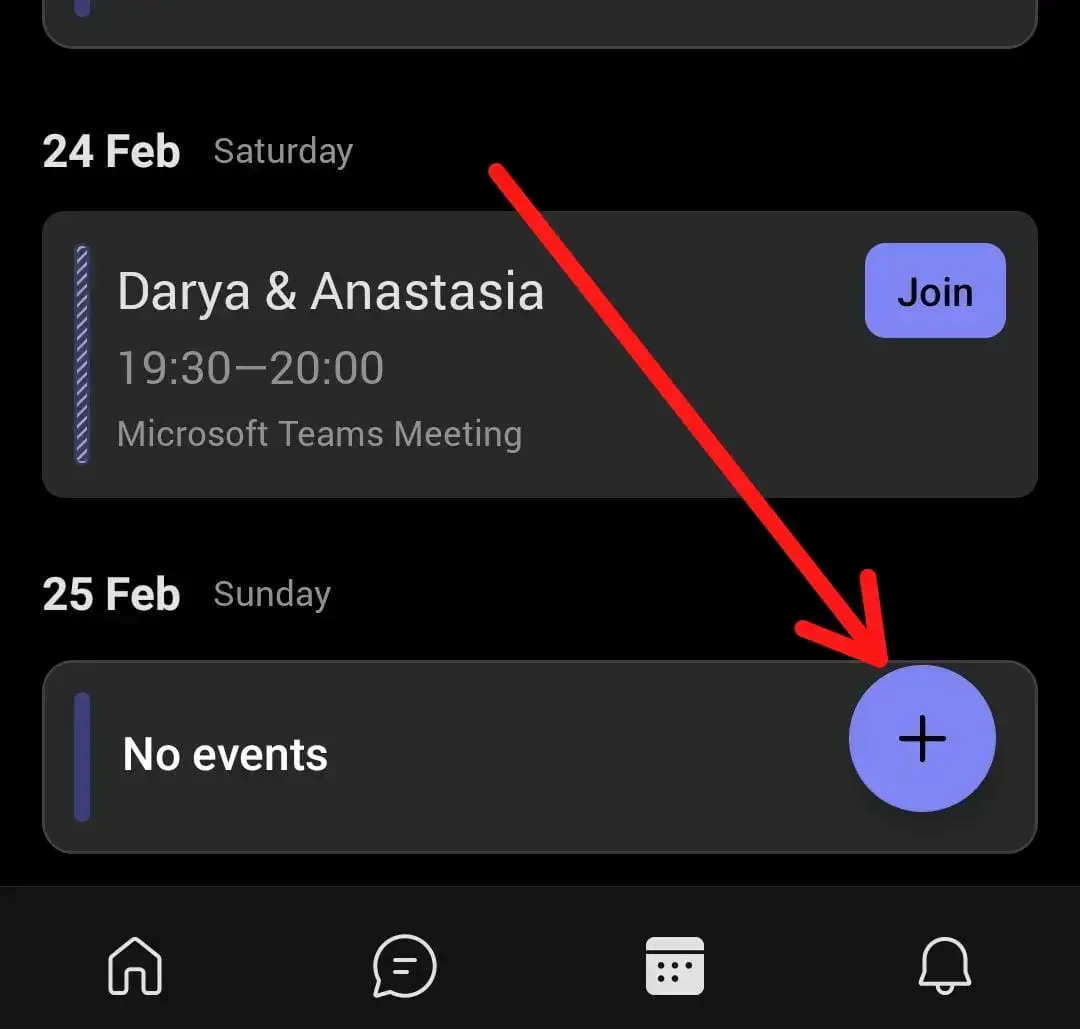
- In the 'New event' form that pops up, tap on the 'Add Participants' button to select the team members you wish to invite.
- Enter the meeting's title and set the time and date.
- Once you fill in all the details, tap 'Done' to complete the scheduling process.
NOTE: You can share the meeting with an entire channel by selecting 'Share to a channel.'
How to Join a Microsoft Teams Meeting
If joining a Teams meeting is something you haven’t done before, we’ve also got you covered!
A. How to Join a Teams Meeting on Desktop
Here’s how to join a Teams meeting on desktop:
- Open Microsoft Teams on your desktop. If necessary, sign in with your account details.
NOTE: If you don’t have an account, no worries! There’s no need to create an account on the platform, as MS Teams allows you to join with your Gmail account as well.
- Find the meeting you want to join. If you haven’t received a meeting invitation email, you can locate your meeting in a couple of ways:
- Via the calendar: Click the ‘Calendar’ tab on the sidebar to see your meetings. Find the one you're joining and click on it.
- Through a chat or channel: If the meeting is linked to a chat or channel, you might also find a meeting link there.
- When you've found your meeting, click the ‘Join’ button. Do this a few minutes before the meeting's start time to adjust your settings first.
- Before you officially participate in the meeting, you can decide whether to turn on your camera and mic.
- With your new settings in place, hit the ‘Join now’ button to access the actual meeting. You're now ready to participate, share, or simply listen.
- During the meeting, feel free to use the chat to send messages, share your screen if needed, or use reactions to interact with the presentation.
- When the meeting concludes, or if you simply need to leave, just click the ‘Hang up’ button, which looks like a red telephone, to exit.
B. How to Join a Teams Meeting on Mobile
Here’s how to join a Teams meeting on a mobile device:
- Launch the Microsoft Teams app on your smartphone. You can download it from the Google Play Store for Android or the App Store for iOS devices.
- Find your meeting. If the meeting link isn’t included in the meeting invite, you can locate it in a couple of ways:
- Through the calendar: Tap the ‘Calendar’ icon at the bottom to see your scheduled meetings and select the one you want to join.
- Via notifications: If the meeting is linked to a team or channel, you might find a notification there.
- On the meeting page, press the ‘Join’ button a few minutes before the start time. You'll move to a screen where you can manage your settings.
- Select whether to turn your camera and microphone on or off, and choose your audio output, like headphones or a speaker.
- After setting up, tap ‘Join now’ to join the meeting. You’re now in the team meeting, ready to participate or listen.
- Feel free to use the chat to communicate with others, share content if necessary, and use reactions to engage with the meeting content.
- When you're ready to leave or the meeting ends, tap the ‘Hang up’ button, shown as a red telephone icon, to exit.
How to Record a Microsoft Teams Meeting on Any Device
Recording Microsoft Teams meetings surely has countless benefits. And with an AI-meeting automation platform like MeetGeek, the entire process becomes a seamless experience, regardless of your Teams license.
Besides automatically recording and transcribing your meetings, MeetGeek offers several powerful features that automate all your post-meeting tasks.
- AI meeting summarization and sharing: MeetGeek automatically summarizes your meeting, pinpointing key discussions, decisions, and tasks. You can easily share this summary with meeting participants, or anyone else who may benefit from the information shared during the meeting.
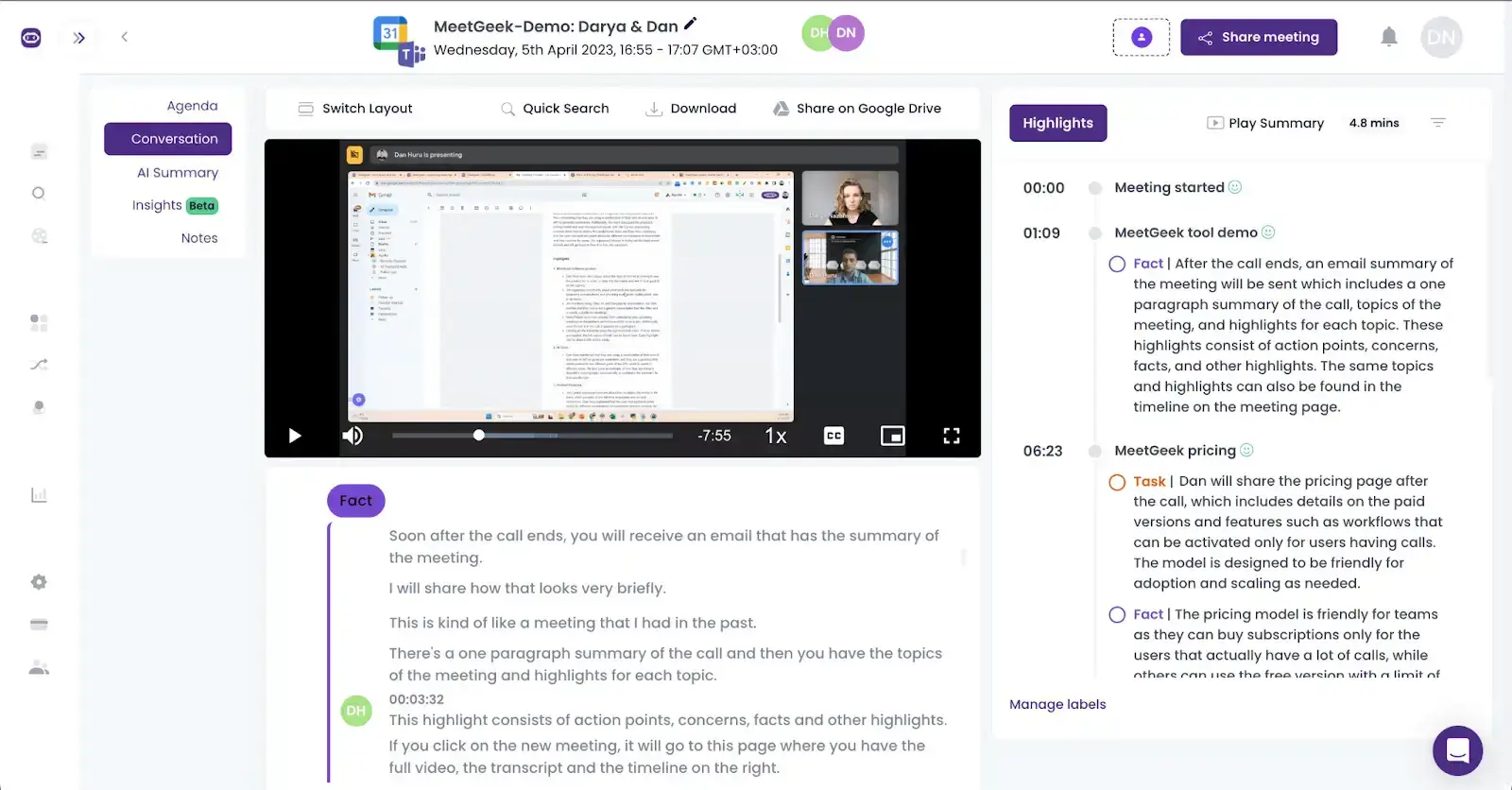
- Meeting repository with sharing options: MeetGeek saves all your meetings in one place, so you can re-watch, download, or share your conversations with others via a secure link. This makes it easy for attendees and stakeholders to revisit the meeting at their convenience.
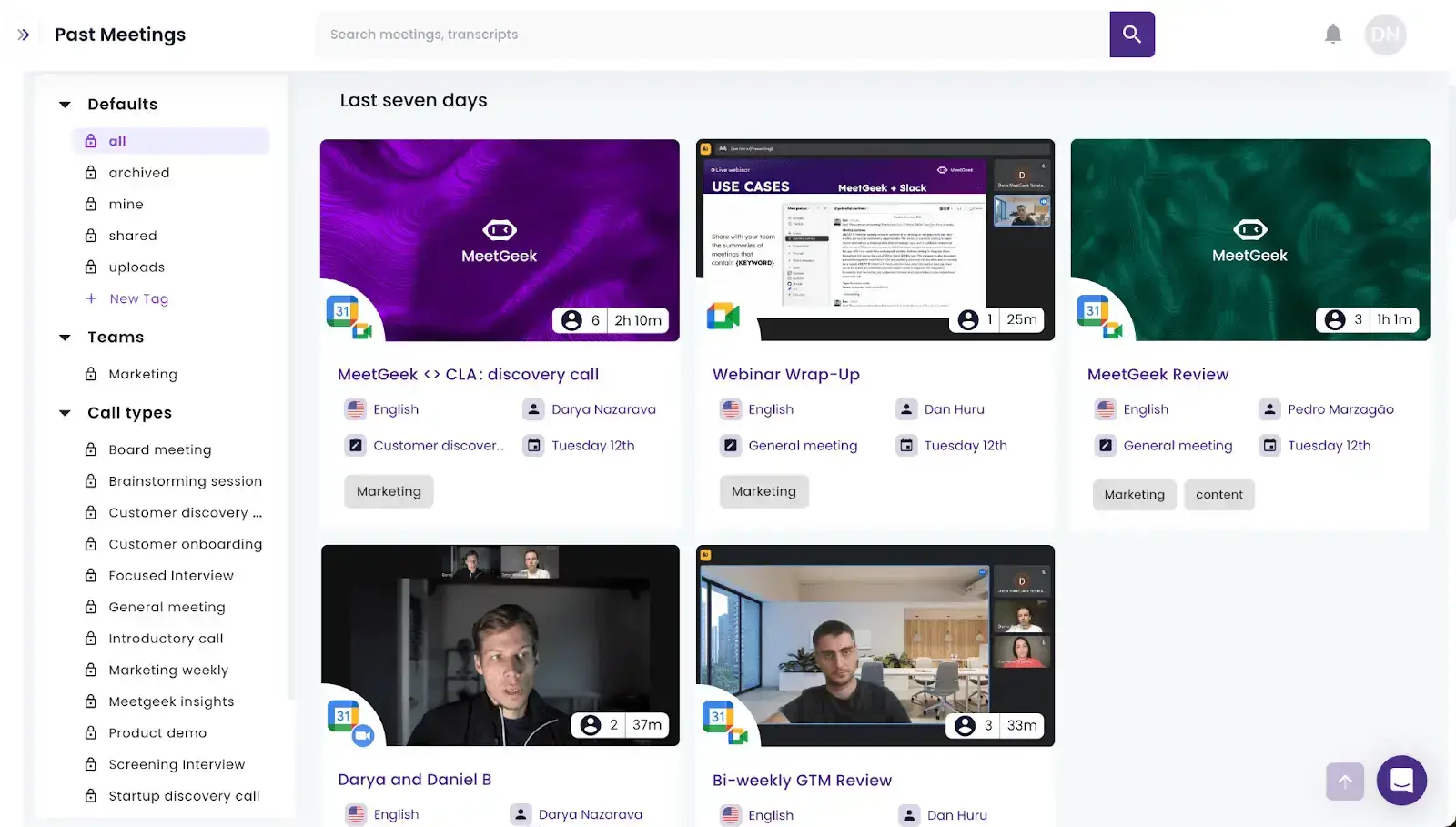
- Action item detection: Through its Task Detection feature, MeetGeek identifies and extracts all the action points from the general discussion, saving you hours.
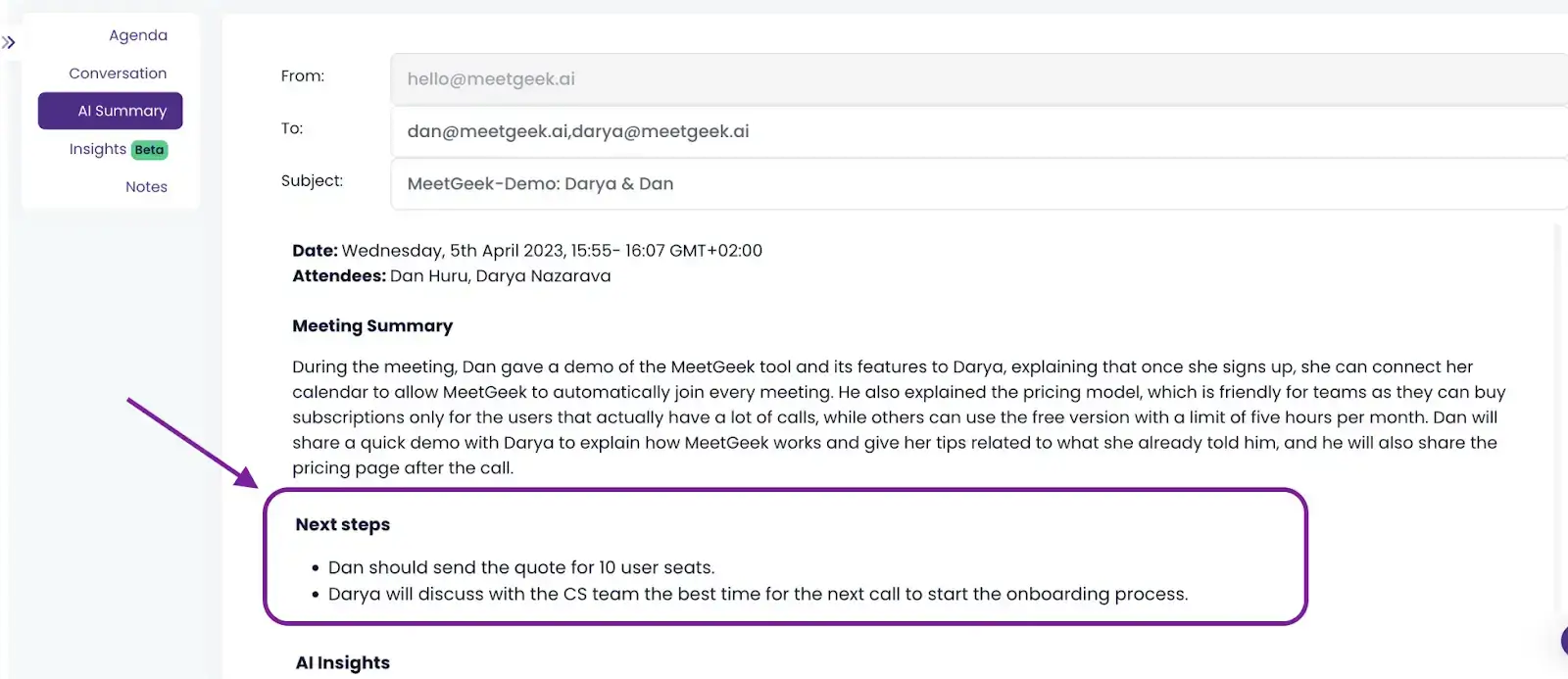
- Seamless workflows: What's more, you can set custom workflows that will directly update your shared workspace with action items. This level of automation allows you to easily check in on the progress of projects to ensure that tasks are moving forward and address any challenges early on.
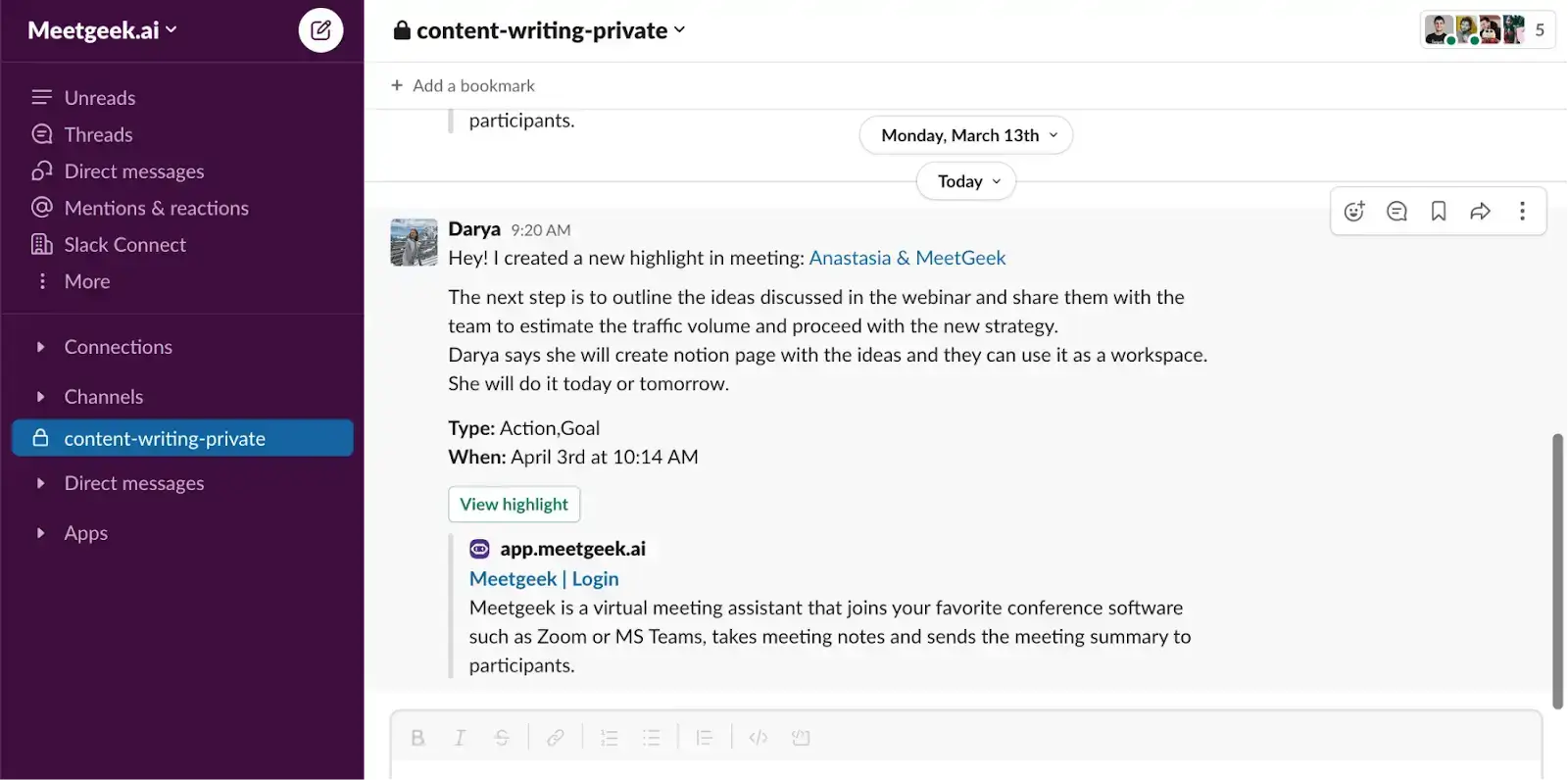
- Streamlined meeting analysis: In evaluating the success of different meeting types, it's crucial to recognize that not every key performance indicator (KPI) applies universally. MeetGeek gives each meeting a unique score, determined by the KPIs you've selected for that meeting's template.
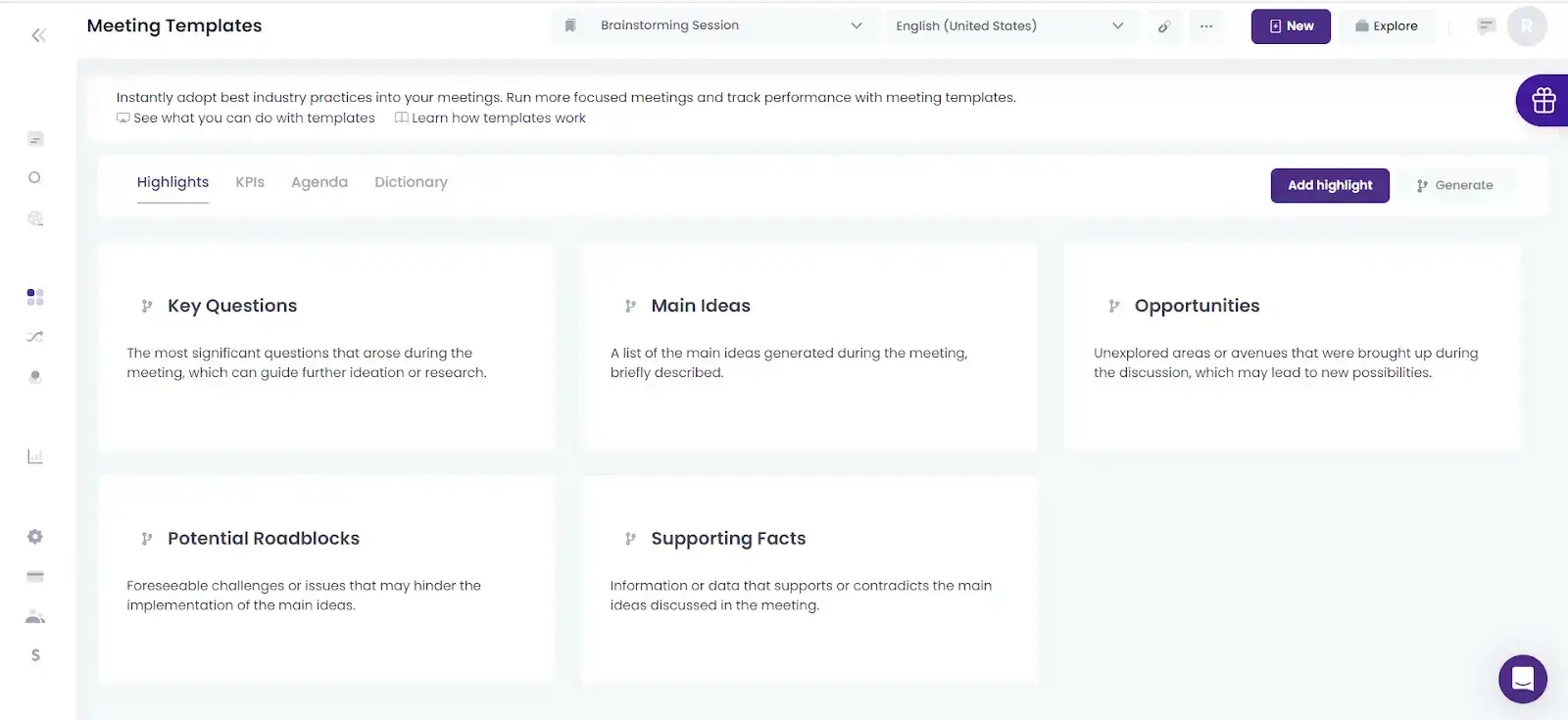
NOTE: This scoring system extends to provide a collective score on a monthly and team basis, offering a broad overview of performance and ensuring your evaluations are focused and aligned with your objectives.
How Do I Set Up a MeetGeek Account?
Integrating MeetGeek with Microsoft Teams simplifies the recording process and enriches the post-meeting experience.
Here’s how to use MeetGeek for recording your Teams meetings on any device:
Step #1: Sign up for a free MeetGeek account directly with your Microsoft account — no extra credentials needed!
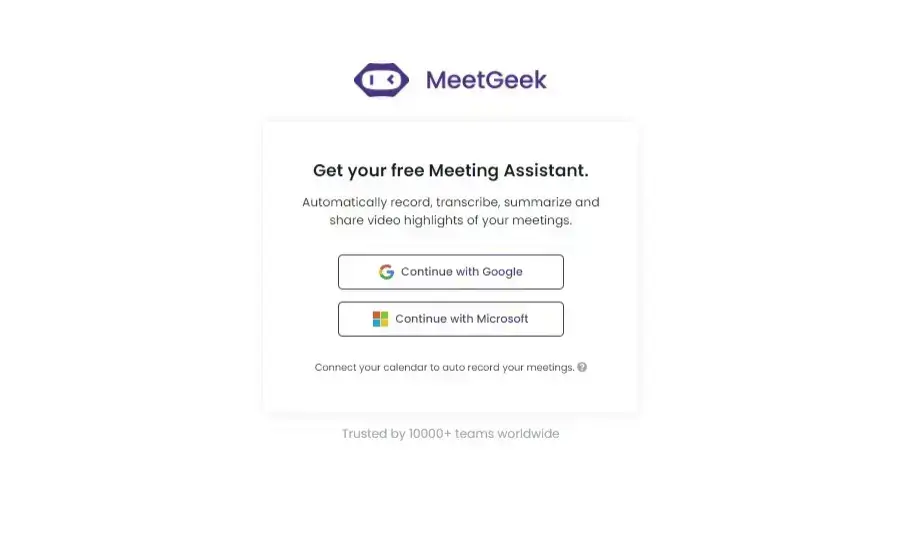
Step #2: Sync your Microsoft calendar with MeetGeek, so the virtual assistant can automatically join your meetings. If you can only access the meeting through a meeting link, paste it into the ‘live ad hoc meeting’ bar.

Step #3: As your meeting begins, MeetGeek joins the conversation as a participant of its own, capturing video, audio, and screen shares, all while respecting privacy and consent norms.
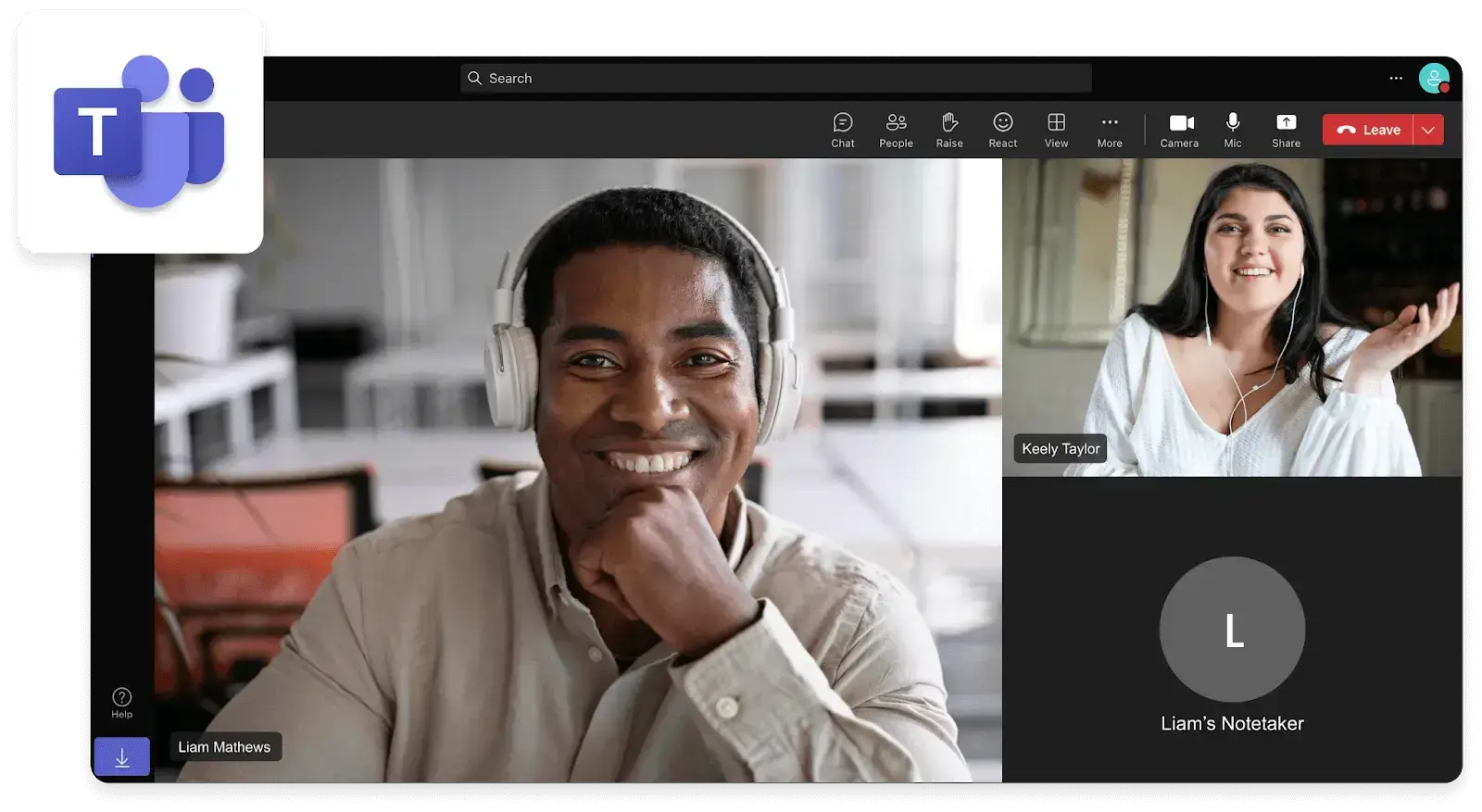
PRO TIP: MeetGeek can even attend the meetings that you can’t be a part of, so you can always be in the loop, no matter what.
That’s as easy as it gets! Start using MeetGeek for free to experience all the added benefits of having a meeting automation platform at your fingertips!
How to Troubleshoot Common Issues with Microsoft Teams Meetings
Fixing common Microsoft Teams meeting issues is all about identifying what's wrong and applying the right solution.
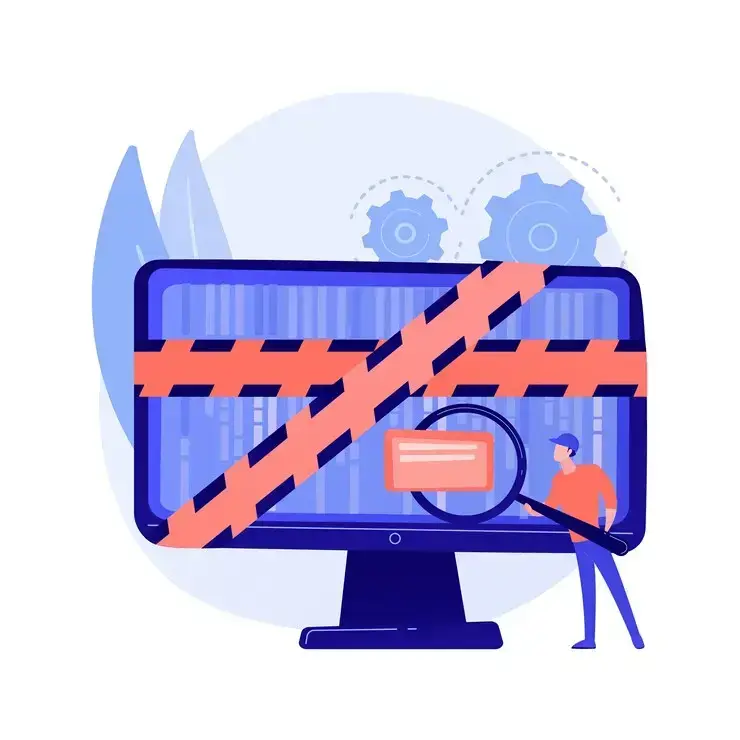
Here's how to troubleshoot the most common issues in Microsoft Teams:
- Audio and video issues
- Confirm your mic, headphones, and camera are plugged in and turned on. If they're Bluetooth, double-check they're connected.
- Head to Settings > Devices in Teams to choose your preferred audio and video devices. Runa quick test to make sure they're working.
- Teams needs access to your mic and camera. Ensure you've allowed this in your computer's settings.
- Connectivity problems
- If you're hitting snags, switch between Wi-Fi and a wired connection, or try reconnecting to your network.
- Can't join? A quick close and reopen of the Teams app might fix it.
- If clicking the meeting link doesn't work, try joining through the Teams calendar or manually entering the meeting ID.
- Meeting quality hiccups
- Apps that hog bandwidth can lower meeting quality. Close anything you don't need.
- Low bandwidth? Turning off your video can make the audio clearer.
- If you encounter glitches, use the network testing tool in Teams (Settings > Network) to find and fix any issues.
- Echo and noise interruptions
- Headphones or earbuds can prevent your mic from catching speaker output, cutting down echo.
- If you're not speaking, stay muted. This reduces background noise and echo for everyone.
- Sharing and permissions issues
- Ensure you're cleared to share content in the meeting. The organizer can adjust these settings.
- Out-of-date Teams apps can cause problems. Update yours through the app or your device's store.
- If sharing content isn't working, exiting and rejoining the meeting might help.
- Internet stability
- For more reliable internet, use a wired connection if possible.
- Connectivity issues often clear up with a simple reboot of your internet hardware.
By following these tips, you should be able to tackle most Teams meeting issues head-on, ensuring a smoother and more productive meeting experience.
Pro Tips to Improve Your Teams Meetings
Now, let’s discuss some actionable tips to help you improve your Teams meetings:
- Schedule meetings in advance
- Encourage camera use
- Leverage meeting recording
- Engage with polls, Q&As, and Whiteboard
- Optimize notifications
- Organize meeting participants
- Follow-up post meeting
1. Schedule Meetings in Advance
When scheduling meetings, always include the meeting agenda in the meeting invite. This not only informs participants about the meeting's purpose but also allows them to prepare in advance, ensuring a focused and efficient discussion.
2. Encourage Camera Use
Advocate for turning cameras on to boost connection and engagement among participants. To address privacy concerns or distracting backgrounds, encourage the use of background blur or custom backgrounds.
NOTE: This feature not only maintains professionalism but also adds a personal touch, allowing participants to express themselves while keeping the focus on the meeting content.
3. Leverage Meeting Recording
Recording your Teams meetings is invaluable for those who cannot attend or wish to revisit discussions.
Always ensure you notify participants that the meeting will be recorded at the start, to ensure you’re compliant with privacy and consent regulations. Make it clear that the meeting recording serves as reference material and will be available to all meeting participants.
PRO TIP: If you’re unsure how to approach this step, check out these meeting recording disclaimer templates for inspiration!
4. Engage with Polls, Q&As, and Whiteboard
Use polls to make quick decisions or gauge opinions, Q&A sessions to address queries efficiently, and the Whiteboard for brainstorming or explaining concepts visually. These can make meetings more dynamic and participatory, keeping attendees involved throughout the entire conversation.
5. Optimize Notifications
To avoid distractions during meetings, optimize your notification settings in Teams. This includes silencing non-essential alerts and customizing notifications for specific channels or meetings.
By minimizing interruptions, you ensure a smoother meeting flow and maintain attendees' focus on the discussion at hand.
6. Organize Meeting Participants
Use Tags and Breakout rooms to manage and organize meeting participants effectively:
- Tags allow you to communicate with specific groups within a larger team, making it easier to address relevant parties.
- Breakout rooms are perfect for dividing participants into smaller groups for detailed discussions or workshops, fostering deeper conversation and collaboration on specific topics.
7. Follow Up Post-Meeting
Following up after meetings is crucial and should be considered a part of meeting etiquette. Send a follow-up email or message through Teams, including key takeaways, assigned action items, and deadlines.
This not only reinforces the meeting's outcomes but also keeps everyone accountable and on track with their tasks.
Supercharge Your Microsoft Teams Meetings with MeetGeek!
Whether you're coordinating with colleagues across the hall or across the globe, Microsoft Teams offers a seamless way to bring everyone together.
By following the step-by-step guide we've outlined, you're now equipped to schedule, customize, and conduct Teams meetings with confidence, even if you're just starting out. Remember, the goal of any meeting is to foster collaboration, generate ideas, and drive actions.
Ready to transform your Teams meetings into powerhouse sessions of productivity? Give MeetGeek a try and discover the difference it can make in your next meetings. Your team—and your meeting agenda—will thank you!
.avif)









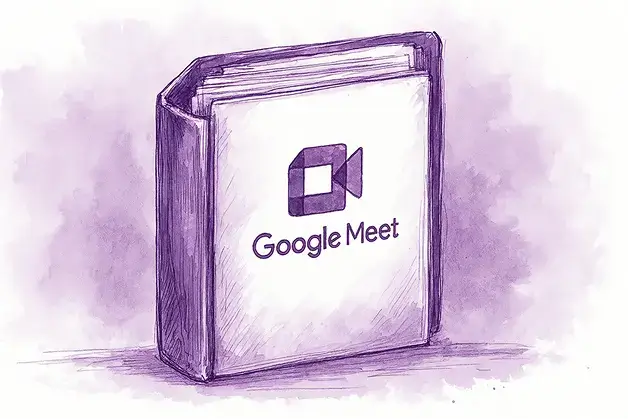


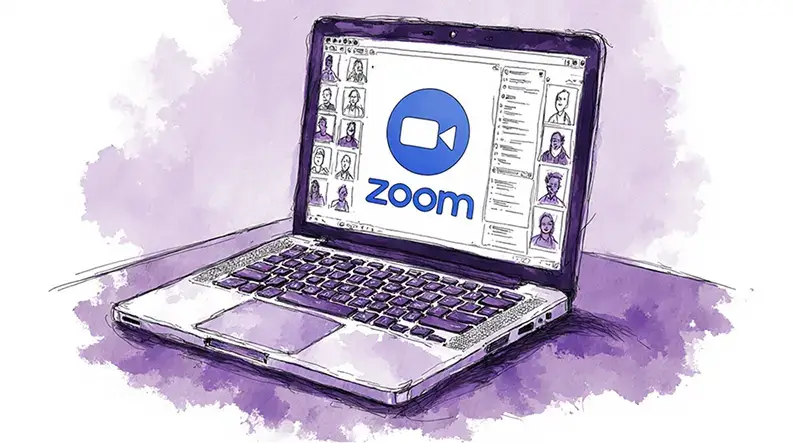


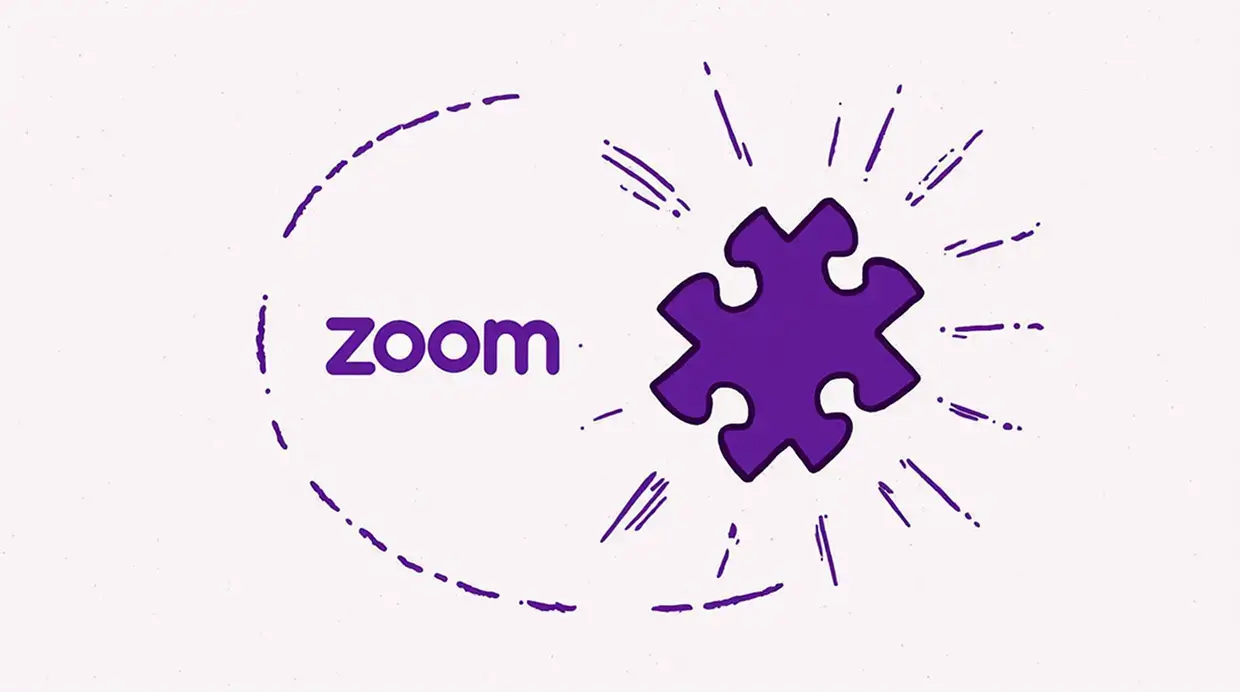



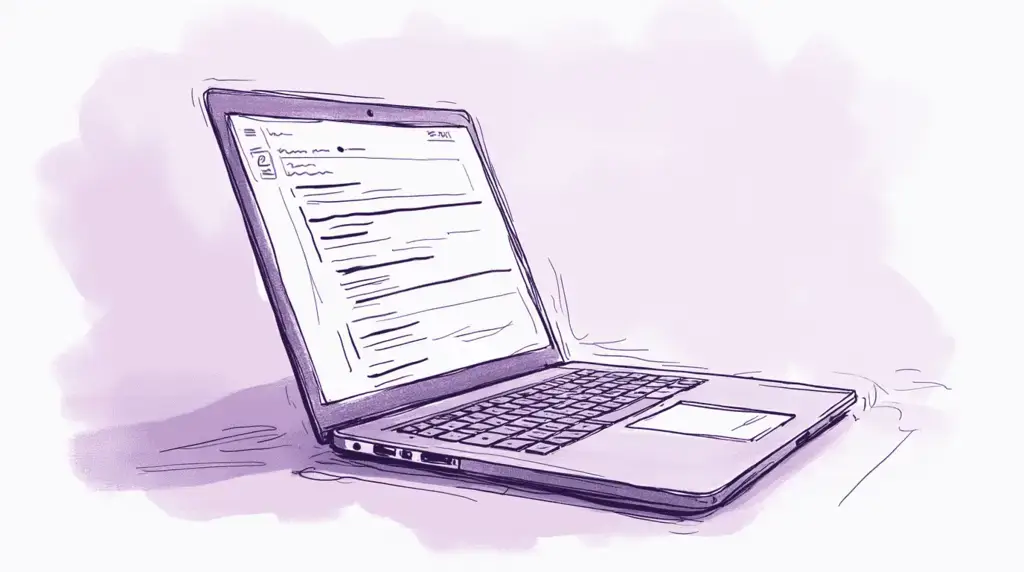




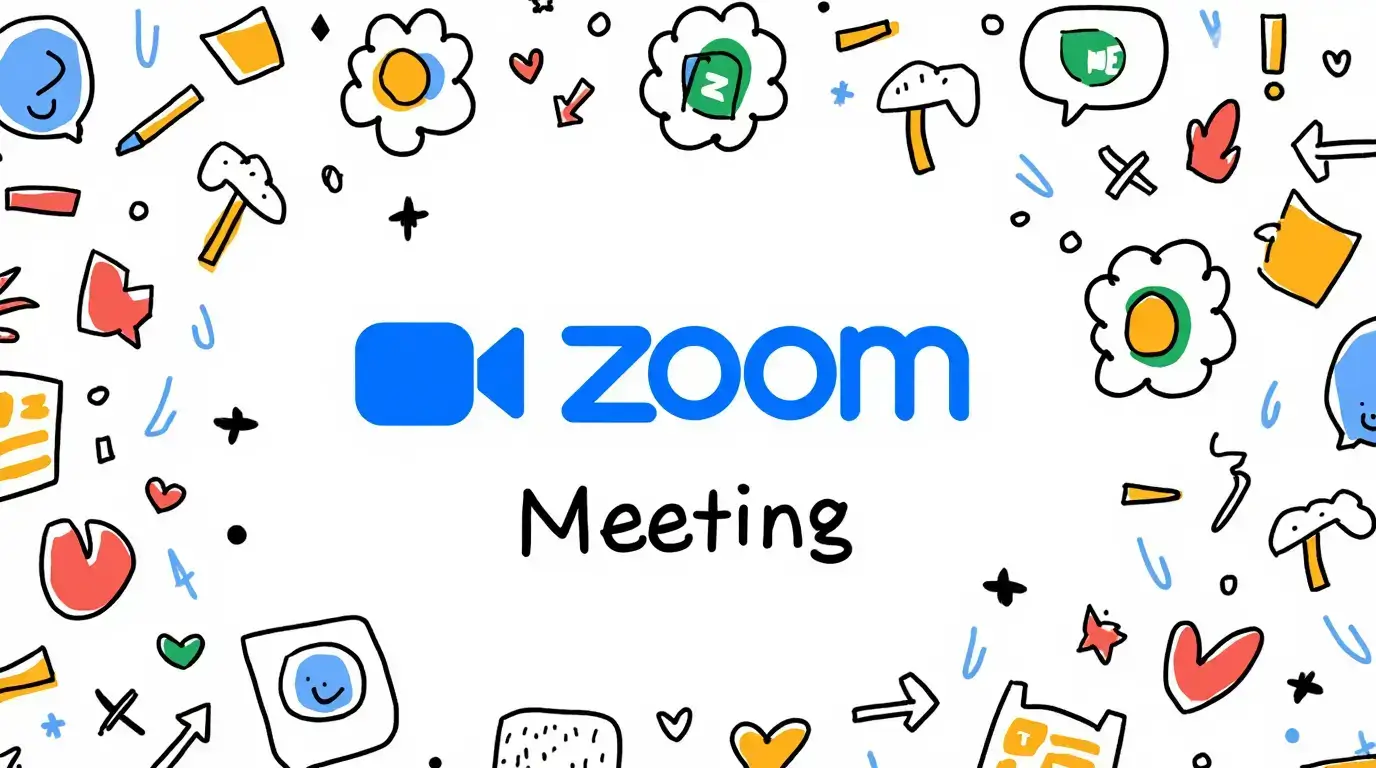




.png)






